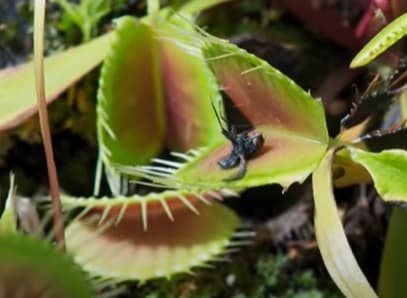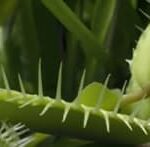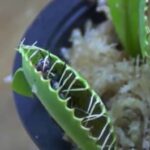As an Amazon Associate, this site earns commissions from qualifying purchases. For more details, click here.
If you haven’t seen a Venus flytrap before, you might be surprised at how small it is. You’ve probably come across the plant in films, albeit way bigger. But how large is the biggest Venus flytrap?
According to Guinness World Records, the largest individual trap for a Venus flytrap is 2.4 inches (6.1 cm). The plant was grown by Jeremiah Harris of Colorado.
By comparison, the trap on a typical Venus flytrap is 1-1.5 inches. Harris’ Venus flytrap is twice as large. This record was confirmed in 2021 by Guinness and still stands.
What are the Largest Venus Flytrap Cultivars?
There are plenty of Venus flytrap cultivars, but when it comes to size the B52 is the most well-known. With the proper care, this cultivar can produce 2 inch traps, twice the size of a typical Venus flytrap.
The B52 was bred by Henning von Schmeling in the US. Whether he named it after the B52 bomber or not isn’t clear, but given its size, that wouldn’t be surprising.
Other large Venus flytrap cultivars include the South West Giant, notable for its traps that can hold bugs up in the air. There is also the G16, Dionaea Girnormous and the DCXL, both of which are larger than the average Venus flytrap
As sizeable as those cultivars are, they don’t quite reach the dimensions of Jeremiah Harris’ Venus flytrap, which he calls “Alien”.
How Big Can a Venus Flytrap Get?
The maximum possible size for a Venus flytrap depends on its environment. With proper care, a Venus flytrap can grow 1-1.5 inch traps or even 2 inch traps if the cultivar is a large one.
But is it possible for Venus flytraps to grow bigger, as in enough to eat prey larger than bugs?
The short answer is no. While Venus flytraps are strong for their size, there are limits to how much it can grow no matter how well you care for it.
Venus flytraps eat insects because the soil they grow in lacks nutrients. The traps, triggers, sensors, digestive fluids and fruity scent are for luring, catching and eating bugs.
If a Venus flytrap grew large enough to eat bigger prey, its traps, digestive fluids, triggers etc. would have to change. It might as well be a different plant.
And large Venus flytraps won’t really stand a chance against other prey. Its traps are still leaves which animals can tear through.
What is the Biggest Insect a Venus Flytrap Can Eat?
Venus flytraps can only eat prey that is one third the size of its trap. Most cultivars have 1 inch traps so the plant can digest 0.5 inch or smaller bugs.
It is true that Venus flytraps will attempt to close their traps on bigger prey -worms or beetles for instance – but the trap cannot hold them in.
If you’re wondering why a Venus flytrap would attempt to trap a bug it cannot eat, that’s because the plant relies on its hairy triggers to determine if something falls into its trap.
If an object falls in the trap and triggers its sensors multiple times, it signals to the Venus flytrap that it is likely prey. It can’t tell though if the bug is too small or big.

Do All Venus Flytraps Grow Big?
No, they do not. The Dionaea ‘Petite Dragon’ has 0.5 inch traps. Another cultivar called Cudo is one of the smallest known for far. While not as much sought after, pygmy Venus flytraps are fairly common.
The size of a Venus flytrap depends on many factors. One of the biggest is its biological makeup. If the cultivar is predisposed to be small like the Cudo, there’s no way it can grow to the size of a B52.
Large cultivars like the B52 can reach their maximum size in ideal conditions. There needs to be sufficient light, water, food, the right soil and ideal temperature.
How Can I Make My Venus Flytraps Bigger?
If you really want a good sized Venus flytrap, get a B52 or any of the bigger cultivars. If you have a pygmy or mid-sized Venus flytrap, it’s just going to stay small.
To make Venus flytraps grow big, provide it with at least 5 hours of direct sunlight. You can use indoor grow lights like Fecida if there’s not enough sun available.
If you want to buy a potted Venus flytrap, check what kind of soil was used. The typical mixture is 2/3 sphagnum peat moss and 1/3 perlite sand. A 4-6 inch pot will be fine.
Venus flytraps prefer moist soil without being too damp. If the soil is too dry or too wet, the plant will not survive.
The best way to approach this is to use the tray method. Fill a tray with an inch of water and put your Venus flytrap in it. Its roots will absorb the water and you should replenish the tray as needed.
Venus flytraps thrive at 70-95 F, but when dormant in winter, can survive in 40 F.
Venus flytraps only need to eat once a week. You can feed the plant if it is indoors and has no access to bugs. But if it is outdoors it will lure insects and fend for itself.
Tips for Growing Large Venus Flytraps
The requirements for growing Venus flytraps are basically the same regardless of size or cultivar. Sun, water, proper soil, 70-95 F temperature and eating once or twice a week.
There are a few things to keep in mind though:
large cultivars tend to soak water faster. If you are using the tray method, you might have to replenish the water more often. Or you can add 1.5 or 2 inches to the tray instead.
These Venus flytraps don’t need to eat more often. But because they have bigger traps, these plants can digest larger insects. Unless you keep the plant indoors at all times, your Venus flytrap will lure bugs by itself.
The deeper the pot, the better. This is essential so roots can spread and encourage growth.
Related Questions
Can a Venus flytrap eat humans?
No. Venus flytraps are too small to people. The biggest cultivar is the B52 and it only has 2 inch traps. Man-sized plants are fictional and Venus flytraps cannot grow to that level.
Venus flytraps eat bugs because the soil it grows in lacks nutrients. Even if we somehow manage to grow a 20 ft. Venus flytrap, it is still just a plant.
its traps look menacing but they’re just leaves. If a man-eating Venus flytrap caught you, you can tear the leaves apart The same is true for other animals.
Why is my Venus flytrap so small?
Lack of sunlight is the most likely cause. Venus flytraps need 5-6 hours of sunlight for optimum growth.
Lack of water, temperature is too hot or too cold and lack of nutrients are also possible causes. There might also be infestations or a disease affecting the plant.
How much food does the biggest Venus flytrap eat?
Large Venus flytraps can grow up 20 traps at a time. But only one or two traps need to eat simultaneously. Feeding all the traps will hurt the plant and could even be fatal.
Venus flytraps expend energy to eat, but it’s able to replenish with the nutrients it absorbs from the food. But too much food could overwhelm the traps.
Will feeding my Venus flytrap often make it bigger?
No. Each trap takes about 5-7 days to digest food. The trap won’t open again until its prey has been digested. When the trap opens, you’ll see the skeletal remains of its prey or some leftover digestive fluids.
Force feeding the other traps is going to hurt the plant. It will slow growth or even be fatal.
Do large Venus flytraps live longer than smaller ones?
Not necessarily. The lifespan of these plants depend on its environment. A Venus flytrap is going to thrive if it gets sufficient light, water, the proper soil and food, regardless of its size.
The opposite is also true. Even the B52 cultivar isn’t going to last if it doesn’t receive enough nutrition and food.

My fascination with carnivorous plants began many, many years ago with Venus Fly Traps. Now I am more than happy to impart what I know with other enthusiasts and those who are curious about meat eating plants.


